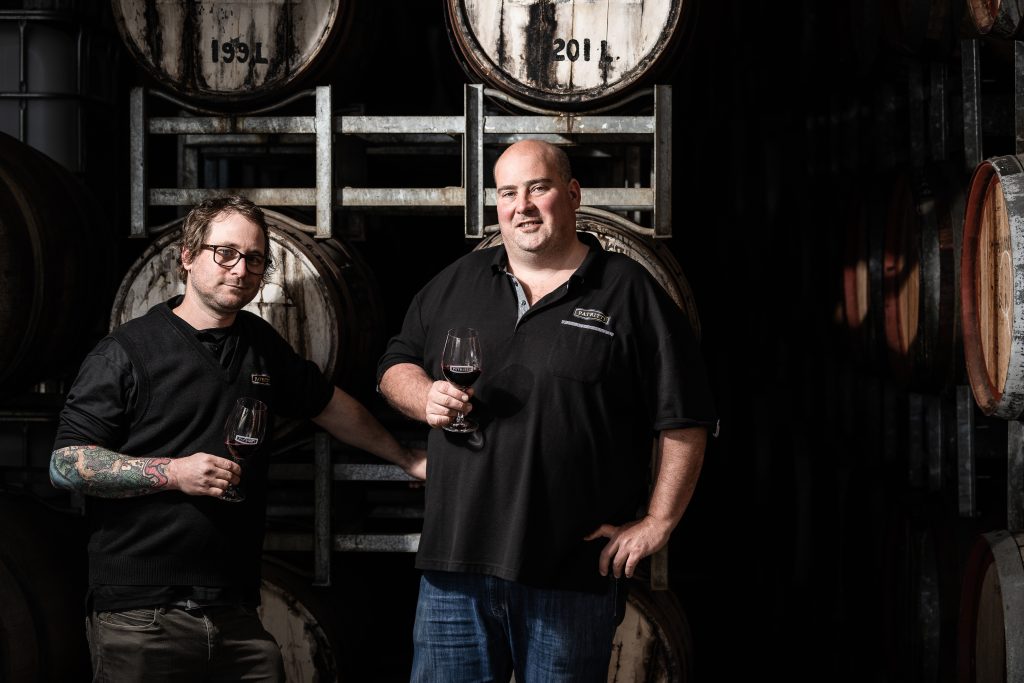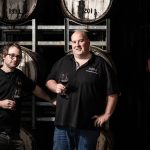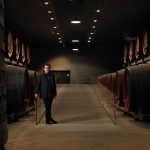
Patritti winemakers Ben Heide and James Mungall.
By Sonya Logan
Patritti had been working with a few alternative varieties, including Saperavi, Barbera, Arneis and Savagnin, when the availability of some so-called Tinta Amarela fruit was brought to its attention in 2012.
The Portuguese variety was growing in a vineyard at Light Pass in the Barossa Valley which had been purchased by Corey Rohrlach in 2011. Corey’s father Wayne was delivering fruit to Patritti’s winery in metropolitan Adelaide the following year when he mentioned that one of the blocks in his son’s vineyard was Tinta Amarela.
“Straight away we were interested and agreed to take the fruit,” recalls Patritti winemaker Ben Heide. “Our first release was from the 2012 vintage. Just before releasing the wine we got Jancis Robinson’s latest book [Wine Grapes] where she suggested the correct synonym for Tinta Amarela should be Trincadeira.
“We love working with anything different, so it was an easy decision to take the fruit. The interesting savoury characters, soft tannins and round mouthfeel of the wine gives it a great place in our wine range,” Heide says, although he admits the winery really didn’t know what to expect when they started processing the fruit.
“We really didn’t know what the fruit was going to give us so we just kept the winemaking very simple so we could assess what we were working with.
“We have made the wine every year since. As we only have a very small amount available, we haven’t always been able to release the wine in every market, each vintage, as a commercial release.”
Corey Rohrlach’s vineyard has a north-south aspect. The two acres of Trincadeira vines within it are believed to be more than 50 years old and are trellised to a double cordon with no catch wires. The vines are hand pruned as hedging is avoided due to low vigour and the double cordon.
Rohrlach says the variety bursts fairly early, but is one of the later reds to be harvested in the vineyard. He adds the only real issue with the variety is that it can be susceptible to sunburn.
Yielding around 2-2.5 tonnes per acre, the fruit is usually machine harvested at night before being crushed and destemmed into a static or open fermenter once it arrives at Patritti.
“With any alternative or emerging variety we generally like to keep the winemaking quite simple to allow the fruit to show its character,” says Patritti’s senior winemaker James Mungall.
“Usually, the fruit will spend seven days on skins with a cultured yeast before it is pressed and combined with the press fractions. We wait for MLF to finish in stainless steel tanks before racking to barrels.
“We use two and three-year-old French and American puncheons for around 12 months before a light filtration and bottling,” Mungall explains.
When asked if the winemaking had been tweaked much since Patritti’s initial release of Trincadeira, Mungall said: “In line with consumer trends towards fresher, lighter styles we have adjusted towards less oak influence and bottling earlier. The wine does benefit from a little time in bottle before release.”
Mungall says Patritti plans to continue to make Trincadeira with no major changes to the winemaking expected.
Patritti’s Trincadeira retails for $28-30 direct from the winery (cellar door and online) and in select retail outlets around Australia. Limited quantities are exported to Germany and the UK. Production is usually limited to around 200-300 dozen each year.
“The wine has a very intriguing aroma and flavour profile; savoury, forest floor, potpourri with lifted fruits, so that gets people interested,” Heide comments. “It’s the mouthfeel that people love most about the wine. It’s soft and round and mouth coating; the tannins are structurally always present but are just so gentle.”
Trincadeira
By Peter Dry, Emeritus Fellow,
The Australian Wine Research Institute

Background
Trincadeira (trin-cah-DAY-rah) originated in Portugal where it is mainly grown in the Alentejo region in the south as either Trincadeira or Trincadeira Preta (‘black Trincadeira’); and in the more northerly regions of Douro and Dao where it is known as Tinta Amarella. Global area (2010) was 9270ha, with almost 100% in Portugal. Trincadeira is used in the Alentejo for table wine, where it is the most significant variety with 2208ha planted. In the Douro it is one of the nine main port varieties and noted for its colour rather than its flavour. It is also a recommended table wine variety in the Dao region.
Trincadeira has many synonyms including: Castiço, Crato Preto, Crato Tinto, Malvasia Rey, Moreto, Mortágua, Mortágua Preto, Mourisco Branco, Mourisco Vero, Mourteira, Mourteiro, Murteiro, Padeiro Bravo, Preto Rifete, Rabo de Ovelha Tinto, Rifete, Rosete Espalhado, Rosete Espanhol, Tinta Amarela, Tinta Amerelha, Tinta Amarella and Tinta Carvallera.
In Australia, the current area is tiny, mainly comprising old vineyards. Trincadeira has been confused with Malbec in some plantings; and has also been known as ‘Portugal’ in South Australia in the past. In the mid-1960s there were about 10ha of Tinta Amarella in the Barossa Valley, and possibly as many as 30ha in South Australia.
Viticulture
Budburst and maturity are mid-season. Vigour is high with semi-erect growth habit. Bunches are medium and well-filled to compact with medium black berries. Yield is moderate to high. Spur pruning is successful in Australia, but it is traditionally cane pruned in Portugal. Trincadeira has average susceptibility to oidium and downy mildew. It is said to prefer dry climates due to its susceptibility to Botrytis bunch rot. A clone of Trincadeira was imported from Portugal after 2010.
Wine
Trincadeira wines are well-structured with good colour, have firm acidity and are medium to full-bodied with generous flavour. Descriptors include plum, floral, spices and pepper. It may be suitable for varietal wines and is considered to enhance other varieties in blends. In Portugal this variety is considered to have the potential to produce high-quality wines if yield is controlled and fruit is fully ripe.
For further information on this and other emerging varieties, contact Marcel Essling at the AWRI ([email protected] or 08 8313 6600) to arrange the presentation of the Alternative Varieties Research to Practice program in your region.




















